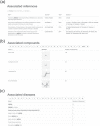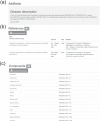Human Breathomics Database
- PMID: 31976536
- PMCID: PMC6978997
- DOI: 10.1093/database/baz139
Human Breathomics Database
Abstract
Breathomics is a special branch of metabolomics that quantifies volatile organic compounds (VOCs) from collected exhaled breath samples. Understanding how breath molecules are related to diseases, mechanisms and pathways identified from experimental analytical measurements is challenging due to the lack of an organized resource describing breath molecules, related references and biomedical information embedded in the literature. To provide breath VOCs, related references and biomedical information, we aim to organize a database composed of manually curated information and automatically extracted biomedical information. First, VOCs-related disease information was manually organized from 207 literature linked to 99 VOCs and known Medical Subject Headings (MeSH) terms. Then an automated text mining algorithm was used to extract biomedical information from this literature. In the end, the manually curated information and auto-extracted biomedical information was combined to form a breath molecule database-the Human Breathomics Database (HBDB). We first manually curated and organized disease information including MeSH term from 207 literatures associated with 99 VOCs. Then, an automatic pipeline of text mining approach was used to collect 2766 literatures and extract biomedical information from breath researches. We combined curated information with automatically extracted biomedical information to assemble a breath molecule database, the HBDB. The HBDB is a database that includes references, VOCs and diseases associated with human breathomics. Most of these VOCs were detected in human breath samples or exhaled breath condensate samples. So far, the database contains a total of 913 VOCs in relation to human exhaled breath researches reported in 2766 publications. The HBDB is the most comprehensive HBDB of VOCs in human exhaled breath to date. It is a useful and organized resource for researchers and clinicians to identify and further investigate potential biomarkers from the breath of patients. Database URL: https://hbdb.cmdm.tw.
© The Author(s) 2020. Published by Oxford University Press.
Figures





References
-
- Boots A.W., Bos L.D., van der Schee M.P. et al. (2015) Exhaled molecular fingerprinting in diagnosis and monitoring: validating volatile promises. Trends Mol. Med., 21, 633–644. - PubMed
-
- Bos L.D., Sterk P.J. and Fowler S.J. (2016) Breathomics in the setting of asthma and chronic obstructive pulmonary disease. J. Allergy Clin. Immunol., 138, 970–976. - PubMed
-
- van der Schee M.P., Paff T., Brinkman P. et al. (2015) Breathomics in lung disease. Chest, 147, 224–231. - PubMed
-
- Phillips M., Herrera J., Krishnan S. et al. (1999) Variation in volatile organic compounds in the breath of normal humans. J. Chromatogr. B Biomed. Sci. Appl., 729, 75–88. - PubMed
-
- De Lacy Costello B., Amann A., Al-Kateb H. et al. (2014) A review of the volatiles from the healthy human body. J. Breath Res., 8, 014001. - PubMed
Publication types
MeSH terms
Substances
LinkOut - more resources
Full Text Sources

